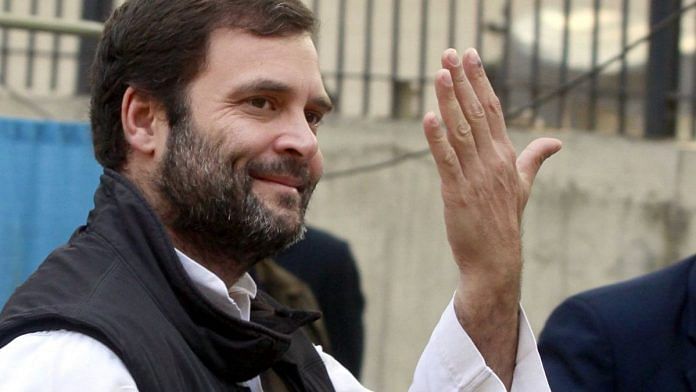While Madhya Pradesh chief minister Shivraj Singh Chouhan’s yatra is in its last leg, Congress hasn’t launched its campaign yet.
Rahul Gandhi’s Kailash Mansarovar Yatra may be a spiritual highpoint in his life. But the Congress president’s two-week long absence from poll-bound states of Madhya Pradesh, Rajasthan and Chhattisgarh has made some of his partymen little edgy.
In Madhya Pradesh, for instance, Congressmen in private conversations ask why Rahul could not show his Shiv bhakti (devotion to Lord Shiva) closer home in Ujjain that houses the Mahakal temple.
The prehistoric Shiva lingam at the Ujjain Mahakal temple is believed to be a swayambhu (born of itself) and is considered one of the 12 jyotirlingas in India.
After all, BJP national president Amit Shah had launched the party’s election campaign for Madhya Pradesh polls, scheduled for November, from the Mahakal temple on 14 July and flagged off chief minister Shivraj Singh Chouhan’s 55-day long Jan Ashirwad Yatra.
Also read: Shivraj Singh Chouhan is channeling his inner Narendra Modi in his penchant for yatras
Chouhan’s yatra is now in its last leg but the Congress is yet to formally launch its poll campaign. The party says that once Rahul returns from the Kailash Mansarovar Yatra, he will visit state capital Bhopal on 17 September.
In the absence of any concrete programme against the Chouhan regime in Madhya Pradesh, the Congress is unable to formally channelise the anger on the ground against the BJP. And, it is manifesting itself in stray incidents of violence.
In two separate instances Sunday, a slipper and stones were hurled at Chouhan in Sidhi district, prompting the chief minister to accuse the Congress of being “thirsty for his blood”.
All this while a Volvo bus, which was used during the Karnataka election to ferry leaders of various factions of the state Congress together as a show of unity, is being parked at MPCC chief Kamal Nath’s 9 Shyamla Hills residence in Bhopal since July. The same bus could see rivals Nath, Digvijaya Singh and Jyotiraditya Scindia travel together. But, Rahul has not found the time to flag it off.
There is a lot of work that needs to be done beyond flagging off the bus. The party needs to finalise alliances with smaller but significant players like the Bahujan Samaj Party (BSP) and the Gondwana Gantantra Party (GGP) in the state.
In addition, resource mobilisation, coordination, identification of talking points, candidate selection process, social media campaigns need to be thrashed out. Anyone faintly connected with the Congress style of functioning knows that in each of these areas, intervention or clearance from the top (read Rahul) is a pre-requisite.
But Rahul’s pilgrimage to Mansarovar is also embedded with political symbolism – an effort at course-correction seen since the Gujarat election campaign.
Also read: Did the Congress benefit from Rahul Gandhi’s temple tourism? Here’s what the data shows
It is also perhaps the first time in the post-Independence history of the Congress that a party president has undertaken such a long spiritual journey. While Jawaharlal Nehru had scant regard and little patience with rituals, Indira Gandhi restricted herself to visiting prominent temples and places of worship, a practice that both Rajiv and Sonia Gandhi followed.
Rahul’s Kailash Mansarovar Yatra seems both spiritual and political. He may have a strong craving to discover his inner-self, but a detached assessment tells a political story too.
After all, since the advent of Sonia in 1997-98, the issue of her faith has been a political subject. Her critics have said that Sonia’s bid to identify herself with Hinduism has much to do with the political compulsions of the time.
But the pressure on Sonia to profess a particular faith did not come from the Hindu right alone. During 1999 general elections when the Sangh Parivar launched a “Ram Rajya” versus “Rome Rajya” campaign (on grounds of Sonia’s Italian origins), the Roman Catholic Association in India took a rather unprecedented step of denying that Sonia was a practicing Catholic. (Page 130, Sonia: A Biography, Penguin 2003).
The question of her faith continued to hound Sonia. In January 2001, Sonia took a holy dip at the Allahabad kumbh when the temperature was barely 10 degrees Celsius. Acting on the advice and guidance from family retainers like M.L. Fotedar and Suresh Pachouri, Sonia had performed Ganga puja, kul devta puja, Ganpati puja and Triveni puja on 22 January 2001. In August that year, she had inaugurated Ganesh Ustav celebrations in Pune and performed aarti and puja of Lord Ganesha. (Page 137-138; Sonia: A Biography, Penguin 2003)
Also read: The cardinal rules of politics Rahul Gandhi needs to learn from young Tejashwi Yadav
For most Indians, both Rahul and Priyanka Gandhi’s Hindu faith could be obvious or a matter of personal choice. But for politically inclined Congressmen, the public display of Rahul’s Hindu identity is important. This was the reason why a janeu dhari Hindu image was created by the Congress spin-doctors and a ‘temple run’ was organised before the Gujarat assembly election.
Some Congressmen feel that just as Sonia’s overt religious acts and identification with the Hindu faith had helped blunt the issue of her foreign origins, Rahul’s Kailash Mansarovar Yatra will bring political dividends too – especially because Madhya Pradesh, Chhattisgarh and Rajasthan are known to be deeply religious and conservative states.
Rasheed Kidwai is an ORF visiting fellow, author and journalist. The views expressed here are his own.




Rumour mongering by Rasheed kidwai Sitting in Delhi . Shameful article
He doesn’t know a bit of Congress
Could Sam Manekshaw have taken fifteen days off between March and December 1971 to visit ancient fire temples in Iran, as an act of spiritual renewal, to strengthen himself for the challenge that lay ahead …